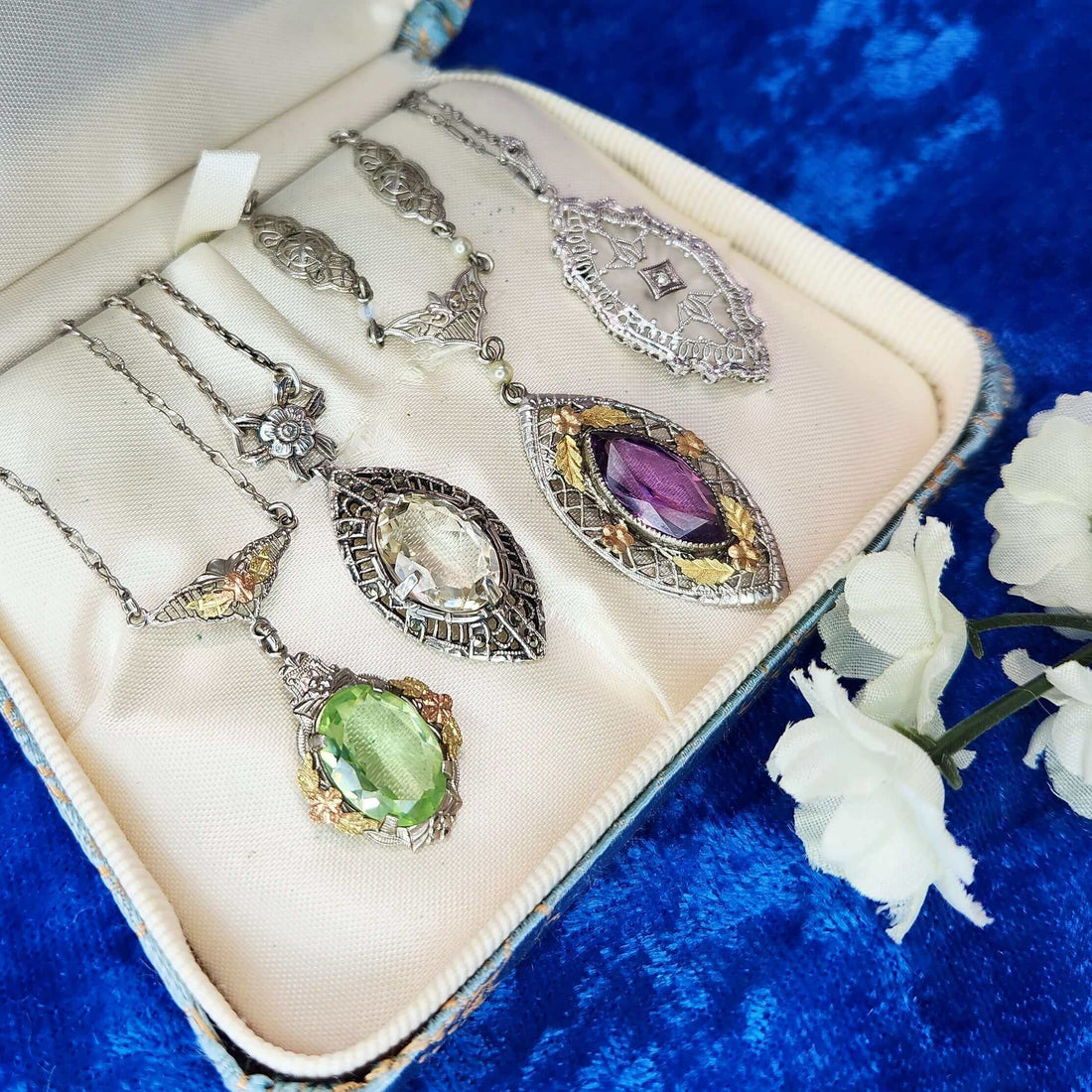
Art Deco Jewelry: Part 1 the 1920s
by Dani Chavez
The 1920s was a decade of bold transformation, from the rise of jazz and flapper fashion to groundbreaking changes in art and design. Among the most dazzling expressions of this era was Art Deco jewelry—an opulent, modern style that captured the spirit of progress and luxury. Defined by geometric patterns, vibrant gemstones, and striking contrasts, these pieces reflected the newfound freedom and excitement of the Roaring Twenties. In this post, we’ll explore the history, design elements, and lasting impact of Art Deco jewelry, a style that remains as captivating today as it was a century ago.

Young women in bathing suits golfing in Washington, D.C. vicinity. July 9, 1926. Image: Shutterstock
Art Deco is considered one of the last original design eras and is still highly collectible today. It emerged after World War I and embodied the youthful “devil may care” attitude that prevailed then. In 1920, the 19th Amendment was passed, giving women the right to vote and freeing women from strict etiquette and attire conventions. This resulted in the popularity of bobbed hair, flapper dresses, and public drinking and smoking. Also, in 1920, prohibition was passed in the United States, banning alcohol, which led to a new era of bootlegging and speakeasies. Drinking illegally became commonplace and added a little excitement to an already thrilling decade.

Par Auteur inconnu — Carte postale - éditeur : Les Éditions artistiques LIP : Paris & ses Merveilles - imprimeur : J. Cormault à Paris, Domaine public, https://commons.wikimedia.org/w/index.php?curid=49887894
Decorative artists experienced a revival in the late 19th century and became recognized as skilled artists. In 1875, the term “arts décoratifs” was coined, giving designers an official title and status. Small groups, known as Société des artistes décorateurs (SAD), were formed around Europe to advocate for artists’ rights. In 1925, the Exposition International des Arts Décoratifs et Industriels Modernes took place in Paris, which changed the design world forever. The World’s Fair ran from April to October, featuring over 15,000 exhibitors from 20 countries. More than 16 million people attended the French government’s effort to showcase the new style of decorative arts in Europe.

STILL LIFE WITH A GUITAR, by Juan Gris, 1913. Image: Shutterstock.com
Various factors influenced the Art Deco style. Picasso and Braque introduced Cubism, a revolutionary art style that relied heavily on geometric patterns and three-dimensional representation. The Vienna Secession and Klimt’s linear forms inspired another significant design element, while Sergei Diaghilev's Ballets Russes inspired the use of brilliant colors.
Genuinely authentic Art Deco goods and jewelry were produced between the two world wars. Anything made after that period can only be considered a revived version of the style. Jewelry from the 1920s, 30s, and 40s shares similar characteristics, but each decade had specific motifs and elements that were popular then.

1920s Bangles. Image: The Gemmary
During the 1920s, established jewelry houses such as Cartier, Boucheron, Mauboussin, Van Cleef, and Arpels played a significant role in pioneering manufacturing techniques and solidifying the quintessential Art Deco style. These jewelry houses paved the way for some of the most technically skilled and gorgeous examples of Art Deco jewels.
Jewelers often used high-value gems of various colors, such as red, green, black, and blue, along with colorless diamonds or rhinestones to create a beautiful contrast that defined the era. Tassel jewelry was particularly popular, with long necklaces dominating the trend.
“Costume jewelry is not made to give women an aura of wealth but to make them beautiful.” – Coco Chanel.
Significant fashion changes occurred during the 1920s, such as the shortening of hemlines and haircuts. Long earrings with elegant vertical lines became trendy again, and sleeveless dresses replaced Edwardian-era evening gowns with relaxed waists. This change led to the popularity of bare arms, highlighting significant jewel-encrusted bracelets and bakelite bangles. Brooches were small and usually worn on the shoulder or pinned on a hat, belt, or bag. Black and white was a widely popular and dramatic contrast among jewelers, with black onyx, diamonds, or rock crystal being the most commonly used materials.

Camphor Glass and Pools of Light Rock Crystal Necklace. Image: The Gemmary
During the mid-1920s, designers were influenced by various cultures, including those from the Far East, Africa, and India. Josephine Baker’s Revue Nègre and the Colonial Exhibitions in Marseilles and Paris sparked a craze for African jewelry and ivory. Interest in Chinese cultures resulted in the creation of intricately carved jade pendants. Inspired by India’s Mogul empire, Cartier crafted large beads of ruby, emerald, and sapphire into leaves and flowers to symbolize the “tree of life.”



